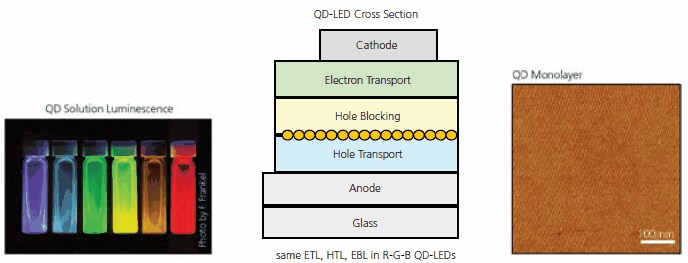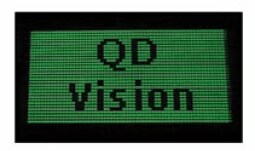The Application of Quantum Dots in Display Technology
Quantum dots (QDs), a nanoscale material with unique optical properties governed by quantum mechanics, have been incorporated into a new display technology under development at QD Vision, Inc. QDs are nanoscale colloidal semiconductors with bandgaps tunable by the size of the colloid. QD Vision combines these materials with organic molecules and processing techniques of plastic electronics to create a new class of solid-state displays. Organic materials are promising for light-emitting devices, including displays, because they can be made inexpensively, can be deposited on flexible substrates, and shine brightly. But an even better device could result if the benefits of organic materials were combined with the unique properties of QDs. While proof of concept QD-LEDs had been made before, these early devices were several orders of magnitude lower in efficiency and brightness than was necessary for a commercially viable device technology. QD Vision’s founders developed new fabrication methods, such as the technique of phase separation1 that allowed QD-LEDs with record efficiencies to be made from QDs and small molecule organic transport materials (such as Alq3 and TPD2 as opposed to the polymers used in previous work).
In many ways, QDs are an ideal lumophore for incorporation into LEDs for large area flat panel displays (FPD). QD emission can be tuned continuously through large portions of the The Application of Quantum Dots in Display Technology electromagnetic spectrum. For example, CdSe Quantum Dots can emit from 470 nm to 640 nm light, almost the entire visible spectrum (Figure 1). Because their emission can be tuned throughout the visible spectrum, they can become the only lumophore that is necessary in a full color flat panel display. Furthermore, QDs have a unique combination of performance attributes not achievable with other lumophores. The ideal OLED lumophore would have high photoluminescence quantum yield, be capable of emitting light from 100% of electrically generated excitons, be solution processable, and have extremely high stability and differential stability (when compared to different color lumophores of the same class). Polymers, dendrimers, fluorescent small molecules and phosphorescent small molecules have all undergone extensive development, but have yet to yield a single material set that meets the complete set of industry needs. Quantum Dots are a new class of lumophores that have the promise to meet all these needs simultaneously.

Figure 1. Left: Vials of fluorescent CdSe QDs dispersed in hexane showing the effect of quantum confinement. QD sizes range from 2 nm (blue) to 8 nm (red) from left to right. CdSe is one example of a QD material that can be used with our device architecture shown in cross-section (Center). The device utilizes only a monolayer of QDs, allowing saturated QD Color emission, while keeping the operating voltage of the device low. Right: AFM micrograph of PbSe QD monolayer showing the nanoscale morphology of the QD monolayer within an infrared emitting device, useful for a wide range of military and communications applications.
QDs also have the potential to allow efficient manufacturing, as they are compatible with solution thin-film deposition techniques, e.g., spin-casting, Langmuir-Blodgett, or dropcasting. Such techniques can be applied to additive processing, and hence can save costly steps in display fabrication. However, these methods place requirements on the substrate onto which the QDs are deposited, do not allow the QD layer to be laterally patterned, and are largely incompatible with the small molecule, transport layer materials that comprise the rest of a hybrid device. These difficulties can be circumvented by the technique of QD contact printing. This dry deposition technique for QD solids ensures that no solvent, or other impurities, would ever contact the device substrate during device fabrication, and allow for the additive, patterned deposition of QDs. Thus, a single step QD deposition process that is high speed, high throughput, and high yield can be envisioned, greatly reducing FPD fabrication costs.
A prototype display that demonstrates the visual appeal of QD Vision’s QD-LED technology is shown in Figure 2. A 64 x 32 pixel monochrome passive matrix display with a 1.4” diagonal dimension emitting in vivid red and green colors have already been developed. The form factor is that of a cell phone display, and its ultrathin 1.5 mm (<1/16th of an inch) profile lends itself to the slim format phones popular today.

Figure 2.Photograph of QD Vision’s prototype QD Display. The prototype is fabricated using the contact printing technique, resulting in high levels of uniformity over a 1.4” diagonal screen.
QD-LEDs have theoretical performance limits that meet or exceed all other display technologies. Phosphorescent OLEDs have the best-demonstrated efficiency of any non-reflective display technology, but QD-LEDs have the potential to exceed their luminous efficiency by over 20%, reducing power consumption significantly. The narrow emission spectra of QDs result in an extremely wide color gamut, and thus QD displays have the potential for color saturation better than both LCD and OLED displays. As an inorganic emitting body, they are far more stable than most organic emissive materials. QD-LEDs offer the combination of high brightness and efficiency with long lifetime, hence differentiating itself from LCDs, OLEDs, and plasma displays.
References
To continue reading please sign in or create an account.
Don't Have An Account?